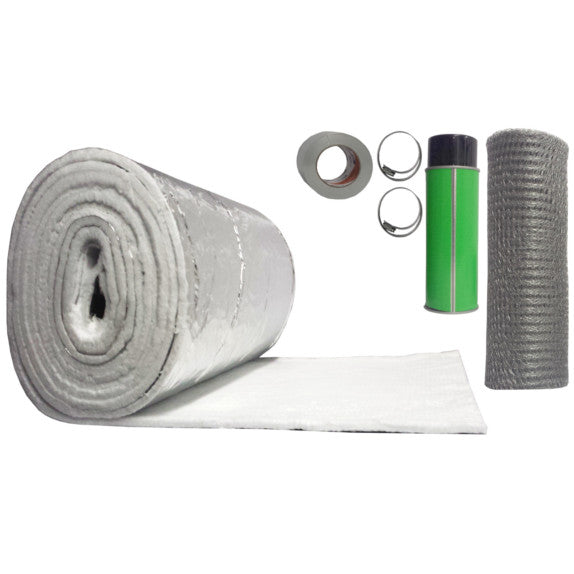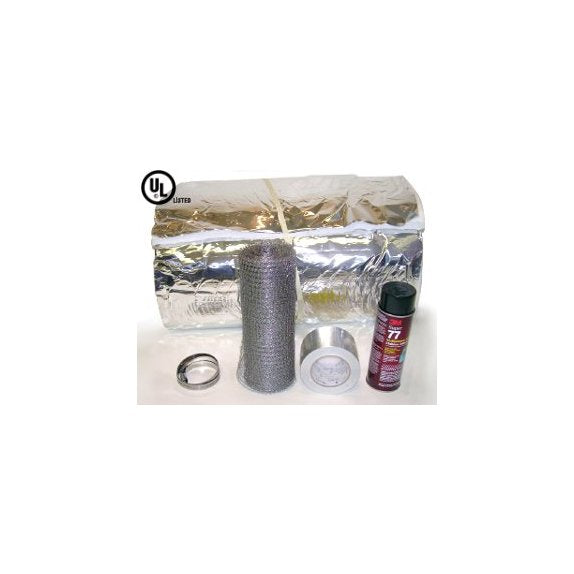Chimney Liner Insulation Blanket Kit
Product Images
Product Details
Help & Documents
Chimney Liner Insulation Kits include everything you need in one box: precisely sized foil faced 1/2" or 1/4" insulating blanket, retractable mesh, spray adhesive, foil tape and clamps. Safer than ceramic wool (aluminum silicates). Moreover, this means less skin irritation — breathe easier knowing that our insulation is carcinogenic free.
Not only is Chimney Liner Insulation used to help prevent chimney fires, but it also keeps flue gases warm, reduces creosote buildup, and meets various code requirements. Rockford's chimney liner insulation is UL Listed for use with our flexible liners and free of carcinogens (unlike the competition's ceramic wool insulation).
Additionally, the diameter in the dropdown menu equals the size of the flexible chimney liner you're insulating.
| Chimney Liner Insulation UL Listing |
|---|
| To maintain UL Listing 1777, 1/2” of insulation between the masonry and the liner provides for zero clearance between the exterior of the chimney and combustible materials. As a result, 1/2” insulation kits will add about 1.5” to the outside diameter of the liner. To maintain UL Listing 1777, 1/4” of insulation between the masonry and the liner provides for 1” clearance between the exterior of the chimney and combustible material. As a result, 1/4” insulation kits will add about 3/4” to the outside diameter of the liner. |
Each Kit Includes:
- AES (Alkaline Earth Silicate) Chimney Liner Insulation Blanket; 3mil protective foil facing insulation wrap
- Insulation Spray Adhesive
- Stainless Steel Retractable Mesh
- HVAC Foil Tape
- Stainless Steel Clamps to secure insulation onto the flexible chimney liner
- Complete Installation Instructions
Video: How to install a flexible chimney liner and insulation blanket
Insulation Requirements & Benefits
Without a doubt, one of the most frequently asked questions is "Do I Need to Insulate My Chimney Liner?". As a matter of fact, for solid fuels, the answer is yes and typically required. On the other hand, it's recommended for gas and oil, but not always required.
For example, here are a few articles we've written to help you understand chimney liner insulation requirements.
- Is Chimney Liner Insulation Required? Read More
- Should My Chimney Be Relined AND Insulated? Read More
- Benefits of Chimney Liner Insulation
- Features of Chimney Liner Insulation
In conclusion, it is always a good idea to insulate your flexible chimney liner if you have room in the flue to do so. Contact a Rockford Certified Technician if you still have questions!
Product Details:
Chimney Liner Insulation Kits include everything you need in one box: precisely sized foil faced 1/2" or 1/4" insulating blanket, retractable mesh, spray adhesive, foil tape and clamps. Safer than ceramic wool (aluminum silicates). Moreover, this means less skin irritation — breathe easier knowing that our insulation is carcinogenic free.
Not only is Chimney Liner Insulation used to help prevent chimney fires, but it also keeps flue gases warm, reduces creosote buildup, and meets various code requirements. Rockford's chimney liner insulation is UL Listed for use with our flexible liners and free of carcinogens (unlike the competition's ceramic wool insulation).
Additionally, the diameter in the dropdown menu equals the size of the flexible chimney liner you're insulating.
| Chimney Liner Insulation UL Listing |
|---|
| To maintain UL Listing 1777, 1/2” of insulation between the masonry and the liner provides for zero clearance between the exterior of the chimney and combustible materials. As a result, 1/2” insulation kits will add about 1.5” to the outside diameter of the liner. To maintain UL Listing 1777, 1/4” of insulation between the masonry and the liner provides for 1” clearance between the exterior of the chimney and combustible material. As a result, 1/4” insulation kits will add about 3/4” to the outside diameter of the liner. |
Each Kit Includes:
- AES (Alkaline Earth Silicate) Chimney Liner Insulation Blanket; 3mil protective foil facing insulation wrap
- Insulation Spray Adhesive
- Stainless Steel Retractable Mesh
- HVAC Foil Tape
- Stainless Steel Clamps to secure insulation onto the flexible chimney liner
- Complete Installation Instructions
Video: How to install a flexible chimney liner and insulation blanket
Insulation Requirements & Benefits
Without a doubt, one of the most frequently asked questions is "Do I Need to Insulate My Chimney Liner?". As a matter of fact, for solid fuels, the answer is yes and typically required. On the other hand, it's recommended for gas and oil, but not always required.
For example, here are a few articles we've written to help you understand chimney liner insulation requirements.
- Is Chimney Liner Insulation Required? Read More
- Should My Chimney Be Relined AND Insulated? Read More
- Benefits of Chimney Liner Insulation
- Features of Chimney Liner Insulation
In conclusion, it is always a good idea to insulate your flexible chimney liner if you have room in the flue to do so. Contact a Rockford Certified Technician if you still have questions!
Help & Documents:
DIY Center
(AKA ‘The Rockford Files’)
From video tutorials to product walkthroughs, we have a variety of DIY resources just for you! Click the button below to view our entire library.








